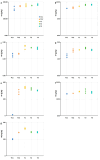Effects of Spent Mushroom Substrate Treated with Plant Growth-Promoting Rhizobacteria on Blueberry Growth and Soil Quality
- PMID: 40284768
- PMCID: PMC12029275
- DOI: 10.3390/microorganisms13040932
Effects of Spent Mushroom Substrate Treated with Plant Growth-Promoting Rhizobacteria on Blueberry Growth and Soil Quality
Abstract
Spent mushroom substrate (SMS) is the residual biomass generated after harvesting the fruitbodies of edible fungi. It is produced in large quantities and contains abundant nutrients. Plant growth-promoting rhizobacteria (PGPR) are a group of plant-associated microorganisms known for their ability to enhance plant growth, improve disease resistance, and boost soil quality. In this study, three PGPR strains with the highest plant growth-promoting potential were selected based on their ability to grow effectively in SMS extract. The SMS substrates were mixed with PGPR solutions and sterile water to establish a batch culture system. The mixture was initially incubated at 28 °C for 3 days, followed by continuous aerobic decomposition in a ventilated environment for 180 days. Based on the quality analysis of the PGPR-treated SMS, the 54-day treatment for transplanting blueberry seedlings was selected. The PGPR-treated substrates showed significantly higher TN, HN, and AP than controls (p < 0.05), suggesting a potential role of PGPR in enhancing nutrient availability. Alpha diversity index analysis revealed significant differences in microbial diversity between the PGPR-treated substrates and the control. Furthermore, the PGPR-treated substrates significantly influenced plant growth characteristics, soil nutrient content, and rhizosphere microbial diversity. Enhanced plant growth characteristics were strongly correlated with increased soil nutrient levels, suggesting a potential link between rhizospheric microbial communities and plant growth performance. This study provides a novel approach and experimental framework for the utilization of SMS and the development of PGPR-based biofertilizers, offering valuable insights into sustainable agricultural practices.
Keywords: PGPR; SMS; blueberry; rhizosphere.
Conflict of interest statement
The authors declare no conflict of interest.
Figures






Similar articles
-
Effects of plant growth-promoting rhizobacteria on blueberry growth and rhizosphere soil microenvironment.PeerJ. 2024 Feb 26;12:e16992. doi: 10.7717/peerj.16992. eCollection 2024. PeerJ. 2024. PMID: 38426138 Free PMC article.
-
Biochar immobilized plant growth-promoting rhizobacteria enhanced the physicochemical properties, agronomic characters and microbial communities during lettuce seedling.Front Microbiol. 2023 Jul 5;14:1218205. doi: 10.3389/fmicb.2023.1218205. eCollection 2023. Front Microbiol. 2023. PMID: 37476665 Free PMC article.
-
Characterization of Plant-Growth-Promoting Rhizobacteria for Tea Plant (Camellia sinensis) Development and Soil Nutrient Enrichment.Plants (Basel). 2024 Sep 23;13(18):2659. doi: 10.3390/plants13182659. Plants (Basel). 2024. PMID: 39339634 Free PMC article.
-
Modification of Rhizosphere Microbial Communities: A Possible Mechanism of Plant Growth Promoting Rhizobacteria Enhancing Plant Growth and Fitness.Front Plant Sci. 2022 May 26;13:920813. doi: 10.3389/fpls.2022.920813. eCollection 2022. Front Plant Sci. 2022. PMID: 35720594 Free PMC article. Review.
-
Insight into soil nitrogen and phosphorus availability and agricultural sustainability by plant growth-promoting rhizobacteria.Environ Sci Pollut Res Int. 2022 Jun;29(30):45089-45106. doi: 10.1007/s11356-022-20399-4. Epub 2022 Apr 26. Environ Sci Pollut Res Int. 2022. PMID: 35474421 Review.
References
-
- Food and Agriculture Organization of the United Nations (FAO) The State of World Fisheries and Aquaculture (SOFIA) 2022: Towards Blue Transformation. 2022. [(accessed on 23 January 2025)]. Available online: https://www.fao.org/3/cc0461en/cc0461en.pdf.
-
- Grand View Research Mushroom Market Size, Share & Trends Analysis Report by Product (Button, Shiitake, Oyster), by Form (Fresh, Processed), by Application (Food, Pharmaceuticals), by Region, and Segment Forecasts, 2023–2030 (Report GVR-4-68039-2023) 2023. [(accessed on 23 January 2025)]. Available online: https://www.grandviewresearch.com/industry-analysis/mushroom-market.
Grants and funding
LinkOut - more resources
Full Text Sources

